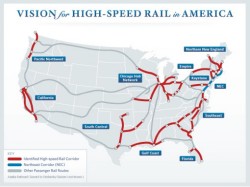
With the Obama Administration’s announcement of $8 billion for high-speed rail projects across America, I wondered if any of that money might help bolster our country’s trail network.
The Rails to Trails Conservancy seemed like a natural place to start, but it turns out that the development of new high-speed rail corridors involves a different set of players than the conversion of old railroad lines into bike trails (which is RTC’s specialty).
I was eventually referred to Champe Burnley, President of the Virginia Bicycle Federation. Mr. Burnley, as it turns out, has been on something of a crusade for the last year to get bike trails alongside new rail corridors and he thinks new high-speed rail corridors would be “ideal” for this purpose.
To illustrate his enthusiasm, Burnley sent me this nice before/after from a presentation he’s been giving;
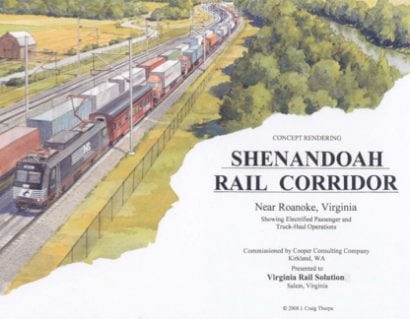
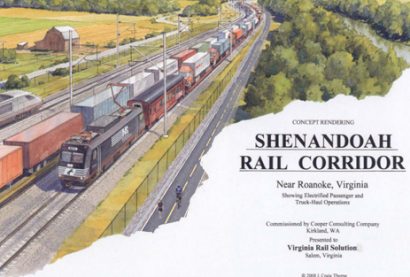
Burnley says “We’ve been pushing hard on the railroads,” but he was quick to add that railroad operators don’t want bikes anywhere near their lines. With high-speed rail — where trains could go over 100 mph — this fears of liability and safety (sincere or not) are certain to impact the discussion.
What we’re going to do is hand this money over to private railroad companies… That’s 8 billion of our money and we deserve benefits of access so we can use these corridors.”
— Champe Burnley, president of Virginia Bike Federation
“The typical argument is that it’s too dangerous to have rail trail, but data just doesn’t support that.” Burnley maintains that having a trail alongside a rail line actually improves safety. He cites a study of rails-with-trail projects that shows reduced trespassing, dumping and vandalism in addition to improved safety because trails tend to “channelize users to safe crossings.”
Burnley also made an interesting point that I hadn’t considered. “What we’re going to do is hand this money over to private railroad companies… That’s 8 billion of our money and we deserve benefits of access so we can use these corridors.”
How does Burnley propose trail advocates get access to these new corridors? He says he’s already spoken with congressional offices about an idea to set aside 2-3% of the new transportation bill to build trails alongside federally-funded rail corridors.
“I’m not sure if we can get the ties in this by the time the transportation bill comes out — but we need to create the mindset.”
Burnley added that since Obama’s announcement, “I’ve gotten all sorts of emails from people who are finally realizing what’s going on.” At VABike.org, Burnley has posted a Rails with Trails Petition that has already been signed by a long list of regional and national bike advocacy groups.
I plan to meet Mr. Burnley at the National Bike Summit coming up in March. I’ll keep you posted on any developments.



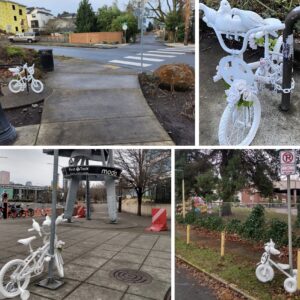
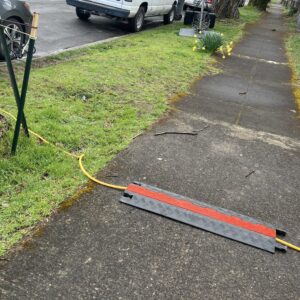
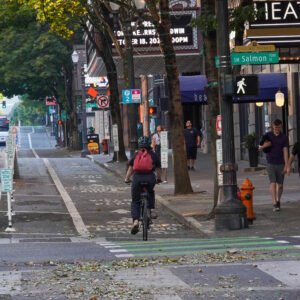
Thanks for reading.
BikePortland has served this community with independent community journalism since 2005. We rely on subscriptions from readers like you to survive. Your financial support is vital in keeping this valuable resource alive and well.
Please subscribe today to strengthen and expand our work.
Excellent idea! This is an opportunity that should not be missed. Long safe rides away from cars- sign me up.
Might want to know that in the US the definition of high speed is 80-90 MPH. We aren’t getting a version of the TGV here or pretty much anywhere with this plan.
As for the money coming to Portland, $8M every cent is going to renovating Union Station, not a penny to rail infrastucture.
Might want to know that in the US the definition of high speed is 80-90 MPH. We aren’t getting a version of the TGV here or pretty much anywhere with this plan.
The corridor in California is planned to top 220 mph. In Florida and Texas, the plan is for somewhere in the neighborhood of 180 mph. The Pacific Northwest might see 150 mph someday, but definitely will see 110 mph in the next decade (in WA).
As for the money coming to Portland, $8M every cent is going to renovating Union Station, not a penny to rail infrastucture.
Not true. Most of it will go to Union Station, but some money will be spent on engineering for a few bottlenecks in NoPo.
The low amount of high speed rail funding going to Oregon is likely a reflection of how low passenger rail enhancements/ investments have been in Salem. Remember last year…when passenger rail service in Oregon was almost zeroed out…one of the two rented Washington State owned Cascade trainsets were about to be sent home, etc.
The other aspect may also have to do with a set of different freight ROW / service ownership in Oregon – Washington State’s Cascade service is on BNSF facilities (vs. OR’s Union Pacific?). BNSF has been quite willing to take anyone’s money to guarantee on time passenger rail service (vs. delay due to freight priority) and make upgrades from single track to double/ multi track.
I think this is an opportunity…especially if the bikepath trail facility can be used by rail companies for access and maintenance purposes. I assume the noise from the planned high speed rail service will not be a problem for trail users yet…but once speeds pass 150 mph then it might.
All in all…I am not surprised at the state of the affair under discussion…the rail companies all got another sweet heart deal to get out of public passenger rail service in the early 1970s …when A.M.T.R.A.K. was born. Our passenger rail speed and headways in this county would make most rail users from 1920 complain – given the state of our other publicly financed transportation facilities (highways, ports, and airports).
The low amount of high speed rail funding going to Oregon is likely a reflection of how low passenger rail enhancements/ investments have been in Salem. Remember last year…when passenger rail service in Oregon was almost zeroed out…one of the two rented Washington State owned Cascade trainsets were about to be sent home, etc.
The other aspect may also have to do with a set of different freight ROW / service ownership in Oregon – Washington State’s Cascade service is on BNSF facilities (vs. OR’s Union Pacific?). BNSF has been quite willing to take anyone’s money to guarantee on time passenger rail service (vs. delay due to freight priority) and make upgrades from single track to double/ multi track.
I think this is an opportunity…especially if the bikepath trail facility can be used by rail companies for access and maintenance purposes. I assume the noise from the planned high speed rail service will not be a problem for trail users yet…but once speeds pass 150 mph then it might be a problem.
All in all…I am not surprised at the state of the affair under discussion…the rail companies all got another sweet heart deal to get out of public passenger rail service in the early 1970s …when A.M.T.R.A.K. was born. Our passenger rail speed and headways in this county would make most rail users from 1920 complain – given the state of our other publicly financed transportation facilities (highways, ports, and airports).
I’d love to have railside trails! I’d have easy graded ways to move around, and I’d know that the guy honking the horn is doing it only at crossings.
With so much talk about high speed rail lately, it’s easy to forget the additional billions being given to railroads to upgrade their freight corridors. The return on that investment should be maximized through additional uses for those rail corridors — non-motorized transportation, recreation, etc.
21 examples of rails with trails in California were featured in a recent report, and there are many more all over the US.
Your community could have them too!
You will never see “high-speed rail” in the United States. The #1 reason is because the Federal Railroad Administration (FRA) won’t allow trains that travel on freight lines to be light enough to effectively accomplish anything over about 160 mph.
The FRA needs to realize that technology has improved and 60 year-old rules regarding crash protection are outdated.
chris, no high speed on the current lines wont happen, at least not true 220 or 300mph like europe, china, and japan have (or are getting) high speed requires totally new tracks, new grades, no road crossings, and new signaling so in that regard its new right of ways, and freight cant use them due to the nature of the rails and the need to keep them in top form. so freight has its lines and the true passenger service has its lines, with maybe slower rural routs using older freight lines, eg going from the main line to a small town.
however there is opportunity for all levels of train service to have rail trails next to them, and noise is not an issue, I have been next to high speed lines in france, germany, and spain, and the sound is really not that bad. wind however is a bit of an issue and so traditional chain fences cant be used, some sort of deflector must be used if we are talking true high speed.
this is very logical and the two transportation mediums fit well together, we need to do it!!
As one poster mentions, many miles of freight rail are also scheduled for upgrade. They, too, would be great candidates for rails-with-trails.
Regarding high-speed concerns next to rails-with-trails, Alta Planning did a study and found this really isn’t an issue. See: http://bit.ly/6sMNdC
Sign the online petition calling for RWTs at http://www.railswithtrails.com
Also, I think a good idea would be to have a clean up effort of railway right of way of all of the former telegraph poles and wires. In its place we could create bike paths and interpretive spaces that will be able to tell stories of significant cultural places along the rail route. Given that rail lines go through older town centers, I feel that a project along these lines would kick start a large amount of interest and economic development.